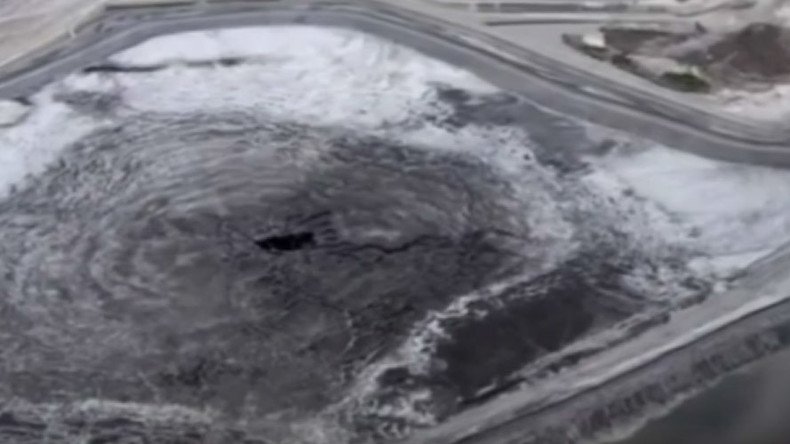Florida company responsible for 215m gallons radioactive water leak admits delay informing public

A sinkhole the size of 300 Olympic swimming pools at a Florida fertilizer plant has leaked radioactive wastewater into the state’s aquifer. It took the company more than three weeks to alert the public. Fixing the leak will cost $20 to $50 million.
The retention pond which dissolved into the 45-foot wide sinkhole contained hazardous waste, including phosphogypsum, a radioactive byproduct resulting from the production of phosphate fertilizer. The 215 million gallons of waste contained uranium, radium and radon gas.
Samples from the groundwater in the Tampa area have so far showed no contamination, according to Mosaic, a phosphate fertilizer facility. But residents with private wells are worried.
The company, with headquarters in Minnesota, said that once monitoring equipment at the Mulberry, Florida site showed a major water loss at the wastewater retention pond on August 28, they notified the Florida Department of Environmental Protection, the US Environmental Protection Agency and Polk County. It took the company until September 15 to notify area residents, however.
“I regret and apologize for not providing information sooner and am committed to providing regular updates to the public as we move forward,” Walt Precourt, senior vice president of phosphates for Mosaic, told the Polk County Board on Wednesday. “[We] realize we could have done a better job in providing timely information to our neighbors and the broader community.”
A Florida Sinkhole Leaking Radioactive Water.
— The Lift (@TheLift) September 19, 2016
WATCH NOW:https://t.co/MnMztNpbGn
Mosaic said the leak will cost them between $20 million to $50 million to fix. Precourt told commissioners they removed as much water from the leaking pond as possible and “are now operating a recovery well to remove the rest of the water from the aquifer.”
“Based on extensive monitoring data, no water from the stack has migrated off our property,” said Precourt.
But the leak was so extensive it reached the Floridan aquifer.
“The pond on top of the cell drained… we estimate that hole is approximately 45 feet in diameter and believe the sinkhole reaches the Floridan aquifer,” said Mosaic in a statement released on September 15.
Huge sinkhole leaks waste into Florida drinking water, concealed for weeks https://t.co/QJzPE0sKfK
— RT America (@RT_America) September 18, 2016
Such potential contamination has raised the issue environmental and health concerns with residents and environmental groups.
“It’s hard to trust them when they ‘Don’t worry,’ when they’ve been keeping its secret for three weeks,” Jacki Lopez, Florida director of the Center for Biological Diversity told Reuters.
‘Environmental breakdown’: Florida Bay hit with huge seagrass die-offhttps://t.co/XxzhR7KYzppic.twitter.com/zqZqMUgsjl
— RT America (@RT_America) April 28, 2016
Lopez said once the contaminants reach the aquifer, which extends from Florida to Georgia, the hazardous waste can travel hundreds of miles.
“We don’t know what the long-term effects will be,” said Lopez. “If I were living in this area, and I had well water, I would be worried about my health.”
Mosaic said its 4,000 employees live and work in the area and they take their responsibility “very seriously.”
Florida nuclear plant cooling water leaking into national park - study https://t.co/ejxpRkrNPSpic.twitter.com/g2Yqun0nYp
— RT America (@RT_America) March 9, 2016
The company said it had reached out to neighbors and offered to pay the costs of testing their wells, and will provide bottled water until the well tests are complete.
“We want our neighbors to not just be safe, but to have peace of mind,” said Precourt.












